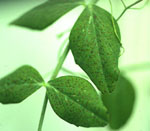| dgl |

|
dgl (degenerative leaf)
This is one of the first two accessions to be included in this collection that did not originate directly from Dr. Marx' own collection. This accession, like the other from this donor, is an iron hyperaccumulating mutant. The donor, Dr. Michael Grusak, is a USDA/ARS Plant Physiologist at the Children's Nutrition Research Center, in Houston, Texas. Dr. Grusak's interest in these mutants is in exploring their use for iron-rich baby foods. This mutant, and the other (brz) express themselves similarly. In fact, the image above is actually of a 'brz' plant, though Dr. Grusak, from whom I got the image, says they look essentially alike. Both of these mutants must be grown hydroponically because they poison themselves with iron when grown in soil, as the narrative below explains. Because of this, I will only be distributing ten of these rather precious seed, for each request. The following is a narrative that Dr. Grusak composed to describe this mutant. With his permission, I have placed it here for your information:
" When grown on a soil or nutrient solution with excess available iron, brown-to-bronze necrotic lesions appear on the leaves and stipules (see photo of brz mutant). Root physiology investigations have demonstrated that elevated rates of root Fe(III) reduction lead to the generation of excess ferrous iron in the root zone, and this leads to iron hyperaccumulation. Necrosis can appear when leaves contain as little as 500 ppm Fe (ug Fe/g dry weight); under certain growth conditions leaf Fe levels as high as 10,000 ppm have been measured. Wild-type pea leaves usually contain 100-150 ppm Fe. Generally, when grown in soil, the Fe stress is lethal and plants do not attain reproductive age. However, if grown with low Fe concentrations until flowering (using hydroponic culture), plants presented with moderate Fe concentrations thereafter (5-10 uM) will exhibit necrotic lesions on leaves, stipules and pod walls. Excess Fe is transported to all xylem-fed organs. In addition, and unlike the brz mutant, plants of reproductive age which absorb excess Fe, have the capacity to transport excess Fe to the developing seeds. Seeds of dgl have been measured to contain as much as 250 ppm Fe; wild-type pea seeds contain 40-70 ppm Fe. If plants are grown with low, but adequate Fe levels, no toxicity symptoms appear on vegetative organs and they cannot be distinguished visually from wild-type. Under these conditions, there is no increase in seed Fe concentration. Manganese concentrations also can be elevated in vegetative tissues, but this depends on the growth conditions. This mutant was originally described in Gottschalk (1987) Pisum Newsletter 19:9-11. Additional information on the dgl mutant can be found in Grusak and Pezeshgi (1996) Plant Physiology 110:329-334. "
If you would like to query for this mutation, click here.

